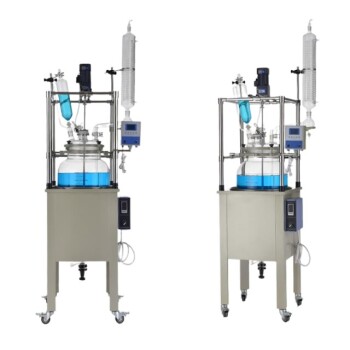A rotary evaporator operates on the principle of reducing the boiling point of solvents by creating a vacuum, allowing for efficient evaporation at lower temperatures. The equipment consists of a rotating flask that forms a thin film of the solvent on its inner wall, increasing the surface area for evaporation. The flask is heated uniformly by a water or oil bath, and the solvent vapor is condensed and collected in a separate flask. This process is particularly useful for heat-sensitive materials and high-boiling-point solvents, as it minimizes thermal degradation and speeds up distillation. The combination of vacuum, rotation, and controlled heating makes rotary evaporation a gentle and efficient method for solvent removal.
Key Points Explained:

-
Reduction of Boiling Point Under Vacuum:
- The core principle of a rotary evaporator is the reduction of the boiling point of solvents under vacuum conditions. By lowering the pressure inside the system, the boiling point of the solvent decreases, allowing it to evaporate at much lower temperatures than it would at atmospheric pressure. This is particularly beneficial for high-boiling-point solvents like water, dimethylformamide, and dimethyl sulfoxide, which can be distilled at temperatures as low as 50°C when the vacuum is reduced to 5 torr.
-
Rotation of the Evaporation Flask:
- The evaporation flask is rotated at a constant speed, which serves two main purposes:
- Increased Surface Area: Rotation creates a thin, uniform film of the solvent on the inner wall of the flask, significantly increasing the surface area available for evaporation. This accelerates the evaporation process.
- Uniform Heating: The rotation ensures that the solvent is evenly heated by the water or oil bath, preventing localized overheating and reducing the risk of bumping (sudden, violent boiling).
- The evaporation flask is rotated at a constant speed, which serves two main purposes:
-
Heating Mechanism:
- The flask is heated by a constant temperature water or oil bath. This provides uniform heating to the solvent, ensuring that the evaporation process is efficient and controlled. The heating is gentle, which is crucial for heat-sensitive materials that could degrade at higher temperatures.
-
Condensation and Collection:
- After the solvent evaporates, the vapor is directed to a high-efficiency glass condenser. Here, the vapor is cooled and condensed back into liquid form. The condensed solvent is then collected in a separate receiving flask. This step is essential for recovering the solvent and ensuring that the distillation process is efficient.
-
Vacuum System:
- The vacuum system is a critical component of the rotary evaporator. It creates the low-pressure environment necessary for reducing the boiling point of the solvent. The vacuum also helps in maintaining a steady flow of vapor from the evaporation flask to the condenser, ensuring that the process is continuous and efficient.
-
Suitability for Volatile and Heat-Sensitive Materials:
- The combination of vacuum, rotation, and controlled heating makes the rotary evaporator particularly suitable for volatile and heat-sensitive materials. The gentle heating and rapid evaporation minimize the risk of thermal degradation, making it an ideal method for distilling delicate compounds.
-
Efficiency and Speed:
- The rotary evaporator is designed to maximize efficiency and speed in the distillation process. The large surface area created by the rotating flask, combined with the low boiling point achieved under vacuum, allows for rapid evaporation of solvents. This makes the rotary evaporator a preferred choice in laboratories for quick and efficient solvent removal.
-
Stepless Speed Regulation:
- Many rotary evaporators are equipped with stepless speed regulation, allowing the user to adjust the rotation speed of the flask to optimize the evaporation process. This feature provides flexibility and control, enabling the user to tailor the process to the specific requirements of the solvent and sample being distilled.
By combining these principles, the rotary evaporator provides a gentle, efficient, and controlled method for solvent removal, making it an indispensable tool in many laboratory settings.
Summary Table:
| Key Feature | Description |
|---|---|
| Boiling Point Reduction | Lowers boiling point under vacuum for efficient evaporation at lower temperatures. |
| Rotation of Flask | Creates a thin film for increased surface area and uniform heating. |
| Heating Mechanism | Uses a water or oil bath for gentle, controlled heating. |
| Condensation & Collection | Vapor is condensed and collected in a separate flask for solvent recovery. |
| Vacuum System | Maintains low pressure for steady evaporation and prevents thermal degradation. |
| Speed Regulation | Stepless speed control optimizes evaporation for specific solvents and samples. |
Discover how a rotary evaporator can streamline your lab processes—contact us today for expert advice!














